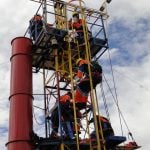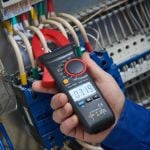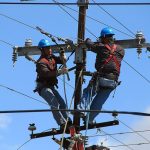Requirements for Certificates Training
Requirements for Issuance of Training or Updating Certificates (Recycling), Improvement or Training
Conditions for issuing Certificates:
The signatures of those responsible for the Multidisciplinary Training Team must include the full names, personal document numbers and numbers of the appropriate Credentials of the Class Council and Assignment of each one.
Therefore, a handwritten signature, lack of identification of the Multidisciplinary Team, or isolated signature, does not fully comply with the legislation.
Our Certificates are issued in accordance with Regulatory Standard 01 (and its annexes) of the Ministry of Labor, among other applicable standards and provisions, meeting the requirements below:
I. Civil Qualification of the Participant (Full Name, RG and CPF);
II. Syllabus based on the applicable Pedagogical Project, listed on the back of the Certificate;
III. Hours of training carried out;
IV. Validity of the Training listed on the front and back of the Certificate;
V. Identification of the student’s performance in the Training (Satisfactory);
SAW. Instructor(s) name, identification, electronic digital signature, qualification and CREA (when applicable);
VII. Name of the technician in charge, identification, signature of the PLH (Legally Qualified Professional) for the training and CREA;
VIII. Date of completion of the training;
IX. Space for the participant’s signature;
X. Issuance of the ART (Technical Responsibility Note) by CREA (if requested);
XI. Information on the Certificate that the participants received didactic material (Handouts, Videos, Standards, etc.) presented in the training.
Training Evidence:
Edited video, photos, digitized documentation, continuous improvement, instructor’s opinion: Consult values.
Our Certificate is valid throughout Brazil, if the Contracting Party performs the Apostille of the Certificate, it may be valid and effective abroad.
The certificates of the vast majority of our competitors and others do not meet the regulatory standards, due to the NR’s requiring that the Certificate signatures be digital, electronic and contain the name of the legally qualified professional and the complementary responsible.
Do a search for models of EAD certificates, and you will see that it only contains a handwritten signature, which is not valid, as recommended by NR-01, see below:
According to Regulatory Standard Nº 01:
1.6.2 The documents provided for in the NR can be issued and stored in digital media with a digital certificate issued within the scope of the Brazilian Public Key Infrastructure (ICP-Brasil), regulated by specific law.
1.6.3.1 The scanning process must be carried out in such a way as to maintain the integrity, authenticity and, if necessary, the confidentiality of the digital document, using a digital certificate issued within the scope of the Brazilian Public Key Infrastructure (ICP-Brasil) .
1.7.1.1 At the end of the initial, periodic or occasional training, provided for in the NR, a certificate must be issued containing the name and signature of the worker, program content, workload, date, location of the training, name and qualification of the instructors and signature of the technical responsible for the training.
2.1.1 The company or specialized institution that offers the training provided for in the NR in the distance and blended learning modality must meet the requirements contained in this Annex and in NR-01 for their certificates to be considered valid.
We strictly comply with Annex II of NR-01:
Guidelines and minimum requirements for using the distance and blended learning modality.
Summary:
1. Purpose
2. General provisions
3. Pedagogical structure
4. Operational and administrative requirements
5. Technological requirements
6. Glossary
1. Purpose
1.1 Establish guidelines and minimum requirements for using the distance and blended learning modality for the training provided for in the NR, regulating both aspects related to the pedagogical structure and requirements related to the operational, technological and administrative conditions necessary for the use of this teaching modality.
2. General provisions
2.1 The employer that chooses to carry out the training through distance or blended learning modalities may develop the entire training or hire a specialized company or institution that offers it, and in both cases must observe the requirements contained in this Annex and NR-01 .
2.1.1 The company or specialized institution that offers the training provided for in the NR in the distance and blended learning modality must meet the requirements contained in this Annex and in NR-01 for their certificates to be considered valid.
2.2 The employer who chooses to hire services from a company or specialized institution must include in the documentation that formalizes the provision of services the obligation by the service provider to meet the requirements set forth in this Annex and in the items related to training set out in the NR.
2.3 Trainings that use distance or blended learning must be structured with, at least, the duration defined for the respective trainings in the face-to-face modality.
2.4 The preparation of the syllabus must cover the required learning topics, as well as respect the workload established for all contents.
2.5 Mandatory practical activities must respect the guidelines set out in the NR and be described in the Pedagogical Project of the course.
3. Pedagogical structure
3.1 Whenever the distance or blended learning modality is used, it will be mandatory to prepare a pedagogical project that must contain:
a) general objective of the training;
b) principles and concepts for protecting the safety and health of workers, defined in the NR;
c) pedagogical training strategy, including an approach to the theoretical and practical part, if any;
d) indication of the technical responsible for the training;
e) list of instructors, when applicable;
f) operational support and control infrastructure;
g) theoretical and practical program content, if any;
h) objective of each module;
i) workload;
j) estimate of the minimum daily dedication to the course;
k) maximum period for completing the training;
l) target public;
m) didactic material;
n) instruments to enhance learning; and
o) learning assessment.
3.2 The pedagogical project of the course must be validated every 2 (two) years or when there is a change in the NR, revising it, if necessary.
4. Operational and administrative requirements
4.1 The employer must keep the pedagogical project available for the Labor Inspection, for the union representation of the category in the establishment and for the Internal Commission for Accident Prevention – CIPA.
4.1.1 The company or specialized institution must make the pedagogical project available to contractors.
4.2 All educational material necessary to participate in the training must be made available to the worker, as per item 3.1 of this Annex.
4.3 Resources and environment should be made available that favor the concentration and absorption of knowledge by the employee, for carrying out the training.
4.4 The period of completion of the course must be used exclusively for this purpose so that it is not concomitant with the exercise of work activities.
4.5 A communication channel must be maintained to clarify doubts, seeking their solution, and such channel must be operational during the course period.
4.6 The verification of learning must be carried out in accordance with the pedagogical strategy adopted for training, establishing the classification with the concept adopted or unsatisfactory.
4.6.1 The learning assessment will take place by applying the test in the face-to-face format,
obtaining, in this way, the record of the employee’s signature, or in digital format, trying out his individual identification and password.
4.6.2 When the learning assessment is online, traceability conditions must be preserved to guarantee the reliability of the process.
4.6.3 The learning assessment process must include practical situations that represent the worker’s work routine for adequate decision-making with a view to preventing work-related accidents and illnesses.
4.7 Upon completion of the course, companies must record their achievement, keeping the result of learning estimates and information on participant access (logs).
4.7.1 The history of the participants’ access record (logs) must be kept for a minimum period of 2 (two) years after the expiration of the course.
5. Technological requirements
5.1 Only training carried out in the distance or blended learning modality that is carried out in a Virtual Learning Environment appropriate for the management, transmission of knowledge and learning of the content will be valid.
6. Glossary
Exclusive environment: physical space distinct from the workstation that provides the worker with the technological resources necessary to carry out the course and adequate comfort conditions for learning.
Virtual Learning Environment (VLE): virtual learning space that offers conditions for permanent interactions (synchronous and asynchronous) between its users. It can be translated as a “classroom” accessed via the web. It allows integrating multiple media, languages and resources, presenting information in an organized way, developing interactions between people and objects of knowledge, elaborating and socializing productions, with a view to achieving certain objectives.
Learning Assessment: aims to assess the knowledge acquired by the worker and the respective degree of assimilation after carrying out the training.
EAD: according to Decree n.º 9.057/2017, Distance Education is characterized as an educational modality in which the didactic-pedagogical mediation in the teaching and learning processes occurs with the use of information and communication means and technologies, with students and teachers developing educational activities in different places or times.
Blended learning: combination of mandatory face-to-face activities with other educational activities that can be carried out without the physical presence of the participant in the classroom, using didactic resources supported by technology, printed material and/or other means of communication.
Pedagogical project: tool for designing the teaching-learning process. It should record the learning objective, the pedagogical strategy chosen for training and training workers, as well as all the information involved in the process.
Instruments for enhancing learning: resources, tools, dynamics and communication technologies that aim to make the teaching-learning process more effective.
Log: computerized record of access to the system. E.g.: access log: access record;
LAW No. 5.194, OF DEC 24, 1966 – CONFEA:
“Section III
Illegal Exercise of the Profession
Art. 6 – Illegally exercise the profession of engineer, architect or agronomist:
a) the natural or legal person who performs acts or provides services, public or private, reserved for professionals referred to in this Law and who is not registered with the Regional Councils:
b) the professional who undertakes activities outside the attributions specified in his/her record;
c) the professional who lends his name to people, firms, organizations or companies executing works and services without his actual participation in their work;
d) the professional who, suspended from his exercise, continues in activity;
e) the firm, organization or society that, as a legal entity, exercises attributions reserved for Engineering, Architecture and Agronomy professionals, in violation of the provisions of the sole paragraph of Art. 8 of this Law.”
Buying our courses has several advantages, such as:
Good price, quality material with a Pedagogical Project, video lessons and updated program content, and most importantly: You receive a certificate that will really be accepted and useful for you and your employer!!!
Accredited and Associated Professionals (Multidisciplinary Team)
Certification:
According to face-to-face workload with at least 70% of use. The PDF Certificates of the Approved participants will be sent to the CONTRACTING PARTIES registered email, as recommended by the Regulatory Standards.
Public Key
The public key is one of the keys that make up a pair of cryptographic keys (the other is a private key, which you’ll see below) in an asymmetric cryptography system. It is disclosed by its owner and used to verify the Digital Signature created with the corresponding private key. Depending on the algorithm, the public key is also used to encrypt messages or files that can then be decrypted with the corresponding private key.
Private Key
Forming a pair with the public key you saw above, the private key is kept secret by its owner, who in this case has a Digital Certificate. It is used and used to create digital signatures and to decrypt messages or files encrypted with the corresponding public key.
How do they work in a Digital Certificate?
The encryption used in Digital Certificates is called asymmetric encryption. This technology uses the two keys you saw above: the public and the private and they are, let’s say, “best friends”. The public key is used to send the information which, of course, is encrypted, that is, the data is protected and proof of interception, until it reaches the recipient’s computer.
And when the information arrives at the destination machine, the user who receives it can use the private key. It is individual and is used to decipher the incoming data.
To give you a clearer idea, imagine transporting money from a store to a bank. The store uses a special safe that is closed with a key (the public one) and places this safe in an armored car (the cryptocurrency), which takes this money completely protected. When these values arrive at the bank, the safe is opened with a second key (the private one) and the money is deposited in the store’s account. Do you understand?
But what is this cryptography present in the keys?
Encryption is the name of the process that encrypts the message according to a protocol approved by the sender and receiver before the process begins.
Briefly, nowadays, it is a technology that transforms information into an unreadable message for anyone trying to intercept it at some point when it goes from one point to another.
What about encryption in the Digital Certificate?
In the case of Digital Certificates, the cryptographic coding is generated by software that performs a series of mathematical operations, imputing a secret key to each message. In other words, when using cryptography, the sender sends a cipher text, all scrambled, and when it reaches the recipient, it will have to be reprocessed (or “unscrambled”) so that he can read the information. And this data will only be able to be accessed if the receiver has the correct key to decode it. And these keys are present in the Digital Certificates.
CLICK TO VIEW
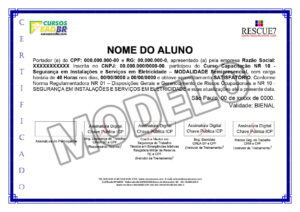
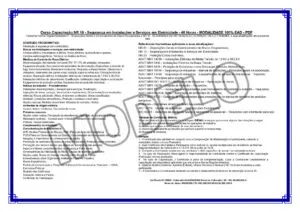
The Certificate will be issued in Portuguese, to comply with Brazilian Regulatory Standards
Heads up:
EAD (Distance Learning), Blended The EAD Certificate also known as Online, according to LAW No. 9.394, OF DECEMBER 20, 1996. can be used for: Complementary Activities; Business valuations; Public Tenders; University Extension; Extracurricular hours; Improved chances of getting a job; Recruitment processes; Internal promotions; Title Tests; Doctoral selections; Master’s Selections; Enter other opportunities. A 100% EAD (Distance Learning) or Blended Course requires a Pedagogical Project is only valid for the Employer, if the SEPRT Ordinance No. 915, of July 30, 2019 – NR 01 – General Provisions of the Special Secretariat Pensions and Work.

